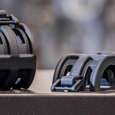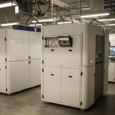
HP’s Multi Jet Fusion (MJF) technology takes a unique approach to building parts from thermoplastic nylon powder, which results in fast build times, improved precision, and consistent mechanical properties throughout the part.
If you’re thinking this process sounds awfully similar to selective laser sintering (SLS), you’re not wrong. But there are some differences between the technologies that should be understood before making your manufacturing selection.
How MJF and SLS Build Parts
Multi Jet Fusion uses an inkjet-style array to selectively apply fusing and detailing agents across a bed of nylon powder. Heating elements fuse the powder into a solid. After a layer is built, a fresh layer of powder is distributed on top of the previous layer and the next phase continues until the part is complete.
The process utilizes an engineering-grade nylon powder, PA 12, so parts are durable and suitable for functional testing and end use. You also have the option to use PA 12 40% glass-filled black powder to further strengthen your parts. MJF's accelerated build speed ultimately leads to reduced manufacturing costs.
While both MJF and SLS use powdered material as their starting points, the big difference is how the material is fused to form layers. While MJF uses a fusing agent. SLS uses a laser to melt the material before moving to the next layer, and it also offers a few other material choices. Both allow you to your nylon parts to give an improved, less-rough, finish.
A Side-by-Side Comparison
Although MJF and SLS are comparable in many ways, there are some important differences. Your part requirements such as feature resolution, surface finish, materials, mechanical properties, and color will ultimately determine the best process for your application.
MJF vs. SLS By the Numbers
| Max. Part Size | Min. Feature Size | Tolerances | Materials Available | Layer Thickness | |
| MJF | 11.1 in. x 14.9 in. x 14.9 in. (284mm x 380mm x 380mm) | 0.020 in. (0.5mm) | For well-designed parts, tolerances of +/- 0.012 in. (0.30mm) plus 0.1% of nominal length for each additional inch can typically be achieved. | PA 12 Black PA 12 40% Glass-filled Black | 0.00315 in. (0.080mm) |
| SLS | 10.6 in. x 12.6 in. x 16 in. (269mm x 304mm x 406mm) For PA 12 parts: 19 in. x 19 in. x 17 in. (482mm x 482mm x 431mm) | Nylons: 0.03 in. (0.762mm) PP and TPU: 0.04 in. (1.01mm) | For well-designed parts, tolerances of +/- 0.010 in. (0.25mm) plus 0.1% of nominal length for each additional inch can typically be achieved. | PA 11 Black (PA 850) PA 12 White (PA 650) PA 12 Mineral-filled (PA620-MF) PA 12 40% Glass-filled (PA614GS) Polypropylene Natural TPU 70-A | 0.004 in. (0.1012 mm) |
Feature Resolution
Multi Jet Fusion parts will have a finer feature resolution of 0.020 in. (0.51mm) compared to 0.030 in. (0.762mm) for SLS. Although, it should be noted that SLS has better small feature accuracy of ±0.001 (0.0254mm) over ±0.004 in. (0.1016mm) for MJF. If a smooth surface finish is a requirement, MJF will be a better choice than SLS. Secondary operations are often recommended for both processes if surface finishes are crucial to your application.
Materials and Colors
SLS will provide you with a broader range of options with multiple nylons as well as a TPU for elastomeric prototyping and polypropylene to get flexible, lighter-weight parts for demanding environments. Also, SLS parts can be dyed a variety of colors. Currently, Multi Jet Fusion offers parts built in PA 12, but you can also get the more rugged PA 12 40% Glass-filled Black for stronger parts. Note that these parts come off the platform as grey but can be dyed black for improved cosmetics.
Comparing Common Nylon Materials
| Material Property | Multi Jet Fusion – PA 12 | SLS – PA 650 | SLS – PA 850 |
| Heat Deflection | 347°F (175°C) | 351°F (177°C) | 370°F (188°C) |
| Tensile Strength | 7.1 ksi (49 MPa) | 290 ksi (1999 MPa) | 7.5 ksi (51.7 MPa) |
| Elongation at Break | 21% | 11% | 30% |
Mechanical Properties
Both processes build parts with highly consistent mechanical properties along all directions of the part’s geometry (aka isotropism). The difference in the fusing process does mean that SLS parts tend to be stronger and more durable than MJF parts, but they also have a rougher surface finish than MJF parts.
Part Size
Another important consideration is part size. SLS provides you a larger build envelope of 19 in. x 19 in. x 17 in. (482mm x 482mm x 431mm) for PA parts. MJF’s build envelope is slightly smaller at 11.1 in. x 14.9 in. x 14.9 in. (284mm x 380mm x 380mm).
Part Quantities
As mentioned earlier, MJF offers accelerated build speed, which means it can support larger quantities in a shorter time frame. However, with either process, you can get parts in as fast as one day.
Comparing Finishes

MJF (PA 12 Black)

SLS (PA12 40% Glass-Filled (PA614-GS))
More info is a click away. Our design guidelines pages for Multi Jet Fusion and SLS have a lot of helpful information, and so do our applications engineers! You can reach them at [email protected].

If you have any issues getting your guide, click here to download.








